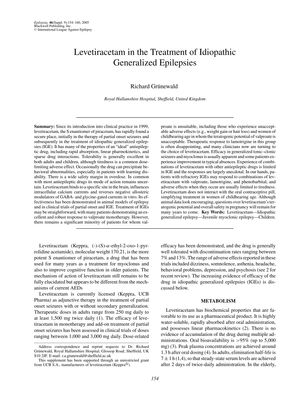Levetiracetam in the Treatment of Idiopathic Generalized Epilepsies
November 2005
in “
Epilepsia
”

TLDR Levetiracetam is widely used and generally well-tolerated for treating idiopathic generalized epilepsies, with tiredness as the main side effect.
Since its introduction in 1999, levetiracetam has become a widely used treatment for idiopathic generalized epilepsies (IGE), after initially being used for partial onset seizures. It is considered close to an "ideal" antiepileptic drug due to its rapid absorption, linear pharmacokinetics, and minimal drug interactions. Generally, it is well-tolerated by adults and children, with tiredness being the main dose-limiting side effect. However, it can cause behavioral issues, particularly in patients with learning disabilities. Its mechanism of action is not fully understood, but it involves binding to a specific brain site and affecting calcium currents and GABA- and glycine-gated currents. Levetiracetam has shown effectiveness in animal models and clinical trials for both partial onset seizures and IGE. It is particularly useful for patients who cannot tolerate valproate due to side effects like weight gain or hair loss, or for women of childbearing age due to valproate's teratogenic risks. While lamotrigine's effectiveness is often disappointing, levetiracetam has shown efficacy in treating generalized tonic-clonic seizures, myoclonus, and sometimes improves typical absences. Combination therapy with levetiracetam and other antiepileptic drugs has been anecdotally successful in refractory IGE cases, with tiredness being the most common adverse effect. Levetiracetam does not interact with oral contraceptives, which is beneficial for women of childbearing age. However, its safety during pregnancy and teratogenic potential remain uncertain.
